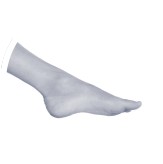
With the Marathon season upon us, stress fractures can be a major cause for concern for any runner. Here we look at exactly what a stress fracture is, some of the common causes and symptoms, and ways that they can hopefully be avoided.
What is a Stress Fracture?
Stress fractures are tiny cracks in a bone caused by repetitive, excessive force going through the bone. Most commonly, it is an injury seen in sports such as gymnastics, cricket bowlers, basketball players and especially long-distance runners.
Stress fractures mostly occur in weight-bearing bones of the lower limb and foot but can also affect the lumbar spine. Essentially the bone is weaker than is required for the activity demands or exercise intensity.
Stress fractures can be put into two categories:
- Those that occur due to excessive force through normal, healthy bone.
- Those that occur due to normal use of a weakened bone – such as osteoporosis.
Overcoming a stress fracture injury can be difficult because they usually occur in very active people who hate not being able to exercise!
What Causes a Stress Fracture?
A stress fracture is an overuse injury, which occurs when your muscles become fatigued and are no longer able to absorb the high forces going through your body when running or jumping. The fatigued muscles transfer the stress overload to the bone, resulting in a stress fracture.
Common causes of stress fractures in runners include:
- Increasing the intensity of your training too quickly ie increasing mileage and frequency of runs too rapidly.
- Running on hard surfaces like concrete or tarmacked roads.
- Wearing incorrect footwear – trainers that are worn out, or too rigid or too flexible for your running style.
- Not doing enough muscle strength and endurance training, meaning that your muscles fatigue quickly, increasing the stress going through your bones.
- Gender – Stress fractures are more common in females.
Where do Stress Fractures occur?
The most common sites of stress fractures include:
- Tibia or shin bone
- Metatarsal bones in the foot
- Medial or lateral malleolus in the ankle
- Femur (thigh bone)
- Hip and pelvis
- Lumbar spine
What are the Symptoms of a Stress Fracture?
Pain with activity is the most common complaint with a stress fracture. It is often high intensity, sharp pain felt locally to the fracture site and that is made worse with activity, and subsides with rest and offloading the affected leg.
Usually, it will hurt to press on the bone, and the pain will get progressively worse as you continue to run on it, eventually it will likely hurt while walking or even when you’re not actually putting any weight on it at all.
Sometimes the muscles in that leg will also feel stiff and tight.
If you suspect you have a stress fracture, you should see an orthopaedic consultant as soon as possible to get it diagnosed.
How are Stress Fractures Diagnosed?
X-rays are most commonly used to determine stress fracture, although sometimes, the stress fracture cannot be seen on regular x-rays, so computed tomography (CT) scan or magnetic resonance imaging (MRI) might be necessary.
Your consultant will take a full subjective assessment, asking questions about the nature of your symptoms and pain, any aggravating and easing factors, and about your training routine. They will also ask you about your past medical history.
From a subjective assessment they will have a very good idea of the cause of your symptoms, but will then examine you to confirm their hypothesis.
Categories of Stress Fracture
Stress fractures can be either low risk or high risk.
Low-risk fractures include shin the bones and metatarsal fractures. These require a shorter period of rest, and may or may not need to be immobilised in a boot.
High-risk fractures are fractures that affect areas known to heal poorly, such as the femur, pelvis and a small bone in your foot called the navicular. These require a much more cautious approach and will need to be completely offloaded with crutches for a number of weeks.
Stress fractures above the knee can also be particularly troubling from a medical standpoint, as the femur, pelvis, and low back are among the strongest bones in the body; a stress fracture to these areas may indicate an underlying medical problem.
How are Stress Fractures Treated?
The most important treatment is rest. Individuals need to completely rest from the activity that caused the stress fracture for six to eight weeks. With a high-risk fracture the patient should not even engage in any low weight bearing activities.
If your consultant feels it is safe, below-knee stress fractures can sometimes tolerate activities like swimming or cycling, however, if activity is resumed too quickly, larger, harder-to-heal stress fractures can develop.
Other specialists who can help with the management of stress fractures include:
- Physiotherapist – for whole lower limb and core muscle and joint function
- Sports Dietitian – to ensure adequate nutrition.
- Podiatrist for foot biomechanics assessment
How to Prevent Stress Fractures
- Gradually build up your mileage using a 10% rule – You should only increase your weekly mileage by 10% of the previous week.
- Make sure you include enough rest days, you should not be running every day.
- Cross-training – Include activities that accomplish the same fitness goals to build up cardiovascular endurance but that are lower impact; such as cycling, swimming or rowing.
- Include muscle strength and endurance training as well as flexibility exercises to ensure that your muscles can cope with the extra demands of your longer distance runs.
- Maintain a healthy diet – Make sure you incorporate calcium and vitamin D-rich foods in your meals. Be guided by a Sports Dietitian.
- Do not wear old or worn running shoes – You may need to be assessed by a sports podiatrist to make sure that you are using the correct trainers for your running style and foot biomechanics.
- See a Sports Physiotherapist – They can undertake a full Musculoskeletal screening and give you advice on training protocols. They can also advise you on a strength programme and if necessary, refer you to a strength and conditioning coach.
- If pain or swelling occurs, immediately stop the activity and rest for a few days. If continued pain persists, see an orthopaedic specialist.
If you can recognise the symptoms early and treat them appropriately, then you can return to sports/activities at your normal level.
At London Bridge Orthopaedics, we have an expert team of Orthopaedic Consultants who are highly experienced in diagnosing and treating all types of stress fractures.
Please get in touch with us to book an appointment asap if you suspect that you have a stress fracture.
We have a dedicated phone line for new patient appointments, which operates Monday – Friday 8am-6pm.
We are covered by all of the usual insurance companies, and we also see self pay patients.









